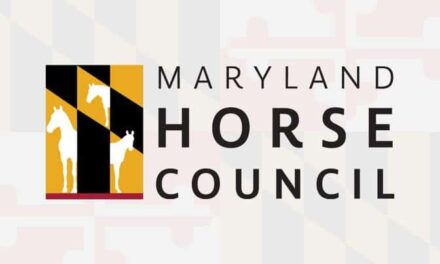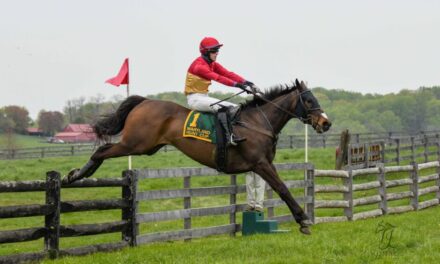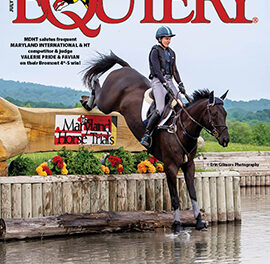
Maryland-bred Eighttofasttocatch winning the 2014 Maryland Million Classic. (Jim McCue/Maryland Jockey Club) The Not For Love gelding earned over $1 million in seven seasons of racing, winning the Maryland Million Classic 3 times, and retiring sound in 2014 to trainer Tim Keefe’s Avalon Farm.
After the blanket of “Black-eyed Susies,” after the weathervane is painted, after the Woodlawn Vase is returned to the museum, and Pimlico is swept clean of the Preakness pomp, what then? What then of the horses?
A flickering two minutes on the first Saturday of May in Kentucky. A heart-pounding two minutes in Maryland. An seemingly interminable two and a half minutes in New York. For fewer than seven minutes each year, Thoroughbreds capture the world’s rapt attention in the Triple Crown Races.
And then what?
Of course, we horse people know the answer to this question. The horses continue to run. A portion of them will have workmanlike careers, earning reasonable returns and keeping the dream alive for thousands of owners and trainers. Another portion won’t make it, and will go on to new careers, or will be retired, maybe to slide into oblivion. And yet another portion will be run and run and run until they are broken down, often beyond repair, as the last possible dollar that can be squeezed out of their racing career is squeezed, sinking ever lower in races, to tracks more obscure than that last.
That wasn’t always the case.
Once upon a time, in Thoroughbred states such as Maryland, the former track horse was the go-to horse for lesson stable mounts, foxchasers and show hunters. They were plentiful and affordable – and talented. Americans took Thoroughbreds to the Olympics, and won.
Then, as time went on, amateur riders began to demand a different kind of horse. Former racetrack horses began to be seen as too much work and too much risk. They developed the moniker of “race track rejects.” Trainers and owners couldn’t give them away, unless they advertised the horse as “never raced.”
The world noticed, and the tide of public opinion began to turn against the racing industry. The racing industry became vilified in the mainstream press. The great Thoroughbred institutions began to grapple with the PR nightmare. But for great institutions, changing course is like turning an aircraft carrier or a merchant marine ship…it takes while. But slowly programs were added or beefed up. The Jockey Club’s Thoroughbred Aftercare Alliance began to grow and flourish.
Meanwhile, “one man’s trash is another man’s treasure.” While some focused on the horses, other savvy horsemen realized that the way to turn the tide back was to educate the people, to convince them that they wanted a former race horse. To create a new demand, to give the former race horse value. “Race-trace rejects” became “off-the-track Thoroughbreds” or “retired race horses.” Grassroots efforts and boots on the ground (or in the stirrup) were able to begin to shift public perception. Again, Maryland led the way when it gave birth to the national Retired Racehorse Project and the Thoroughbred Makeover.

Today, “Catcher” is enjoying a successfully career as a family horse and an eventer, and is ridden by mom Rumsey and daughter Ryan Keefe. The family has established a Facebook page for the popular Thoroughbred!
Opportunities Abound
In 2012, the Jockey Club established the Thoroughbred Incentive Program, and soon there were Thoroughbred horse shows everywhere, including the All Thoroughbred Horse Show, originally held at Pimlico and hosted by the Maryland Jockey Club.
And then, last week, the first International Forum for the Aftercare of Racehorses (IFAR) was held in Washington, DC, coinciding with the Pan American Conference, with sessions on Thoroughbred aftercare and welfare including promoting and retraining these horses and developing non-racing agreements for owners. The keynote speaker was Olympic eventer Boyd Martin, who had competed the off-the-track Thoroughbred Blackfoot Mystery at the Rio Games.
Meanwhile, “back at the ranch” (i.e., here at home), Maryland has a new and exciting program, exciting because the program is the combined cooperative effort of all of Maryland’s Thoroughbred institutions, entities which have not always played nice with each other, and because the program seeks to bridge the gap…the gap that still gives racing a black eye.
Better to retire one start too soon than one start too late
“Beyond the Wire” is a coalition of the Maryland Thoroughbred Horsemen’s Association, the Maryland Jockey Club, the Maryland Horse Breeders Association and various Maryland jockeys for the purpose of facilitating the safe transfer of retired racehorses from Maryland tracks into new homes – before the horses become so broken down they can never be anything more than a pasture ornament.
According to the new program administrator Jessica Hammond, “The program will help move horses from Laurel and Pimlico to Thoroughbred Aftercare Alliance accredited programs for re-homing into new careers.”
The two TAA-accredited Maryland facilities that will participate are the MidAtlantic Thoroughbred Horse Rescue in Chesapeake City and the Foxy G Foundation in Union Bridge.
In order to participate in the program, eligible horses must be based at a Maryland track and run in Maryland for at least three months. Trainers and owners fill out an intake form and the horse is evaluated and checked over by one of the track veterinarians who donate their time. Beyond the Wire will then arrange for transport to either MidAtlantic TB or Foxy G through shippers who are offering the program a very reduced rate. Once at one of these locations, the horse enters into the rescue’s program for re-homing.
If there are already plenty of organizations that are focused on re-homing and reschooling and retraining retired racehorses, why do we need this program?
The audience for Beyond the Wire is not “us,” as in those of us outside of racing who ride Thoroughbreds in other sports. Nor is the purpose of the program to educate more non-Thoroughbred folks into becoming Thoroughbred folks.
The purpose of the program is to educate current racehorse owners and racehorse trainers about options for their racehorses when they can no longer race. The program hopes to bridge the gap by helping them retire horses before they become broken down.

Still too fast to catch! Is this the equine-version of “LOL?” Rumsey Keefe & Catcher enjoying a joke about something – but retiring a horse from the track while it is still sound enough to enjoy a second career is no joke. The Equiery applauds Beyond The Wire!
“Many of the horsemen here in Maryland have already been working towards finding homes for their retirees,” said Hammond. And there are many responsible trainers and owners who do retire their horses while they are still sound enough to go on to another career. But not all of them. There are still plenty of owners and trainers, hard pressed to make a living, that will continue to run horses. “We hope to educate horsemen on the benefits of retiring horses one start too soon versus one start too late,” Hammond explained.
Beyond the Wire was officially launched during Preakness Week and intends to accept horses in the weeks following the closing of the Preakness meet. This year’s Totally Thoroughbred Horse Show at Pimlico will benefit Beyond The Wire.
Meanwhile, the program’s founders estimate that the program will have about $200,000 at its disposal. Currently, there is an $11 per start donation that, according to the MTHA, most trainers support. Additionally, MTHA has pledged an annual $25,000 to support the program.
Funds raised will be used for the horses specifically, according to the MTHA, and not “just to the facilities that care for them.” Completion of a “horse intake form” and a veterinary evaluation are mandatory when a horse enters the program. The Jockey Club will be notified of participating horses, and their foal papers will be stamped “not for racing.”












